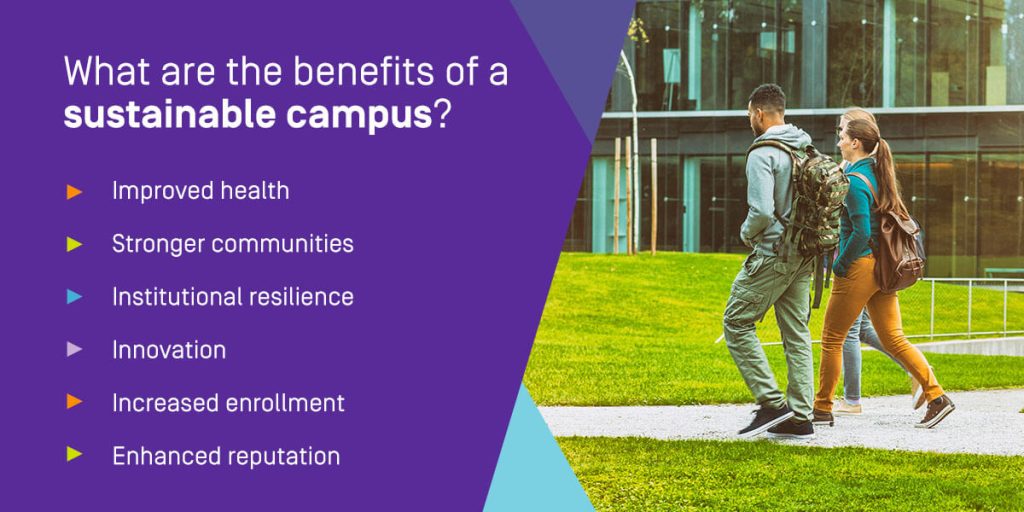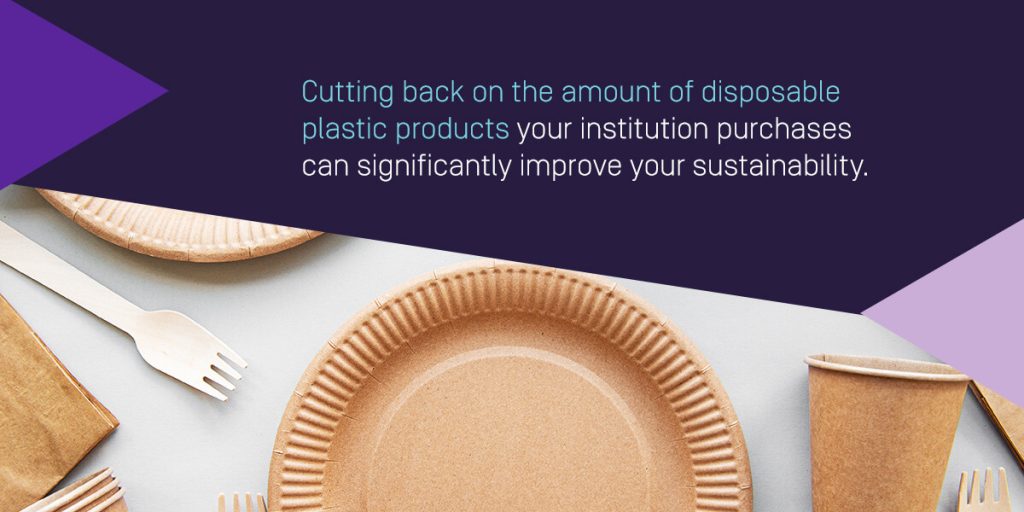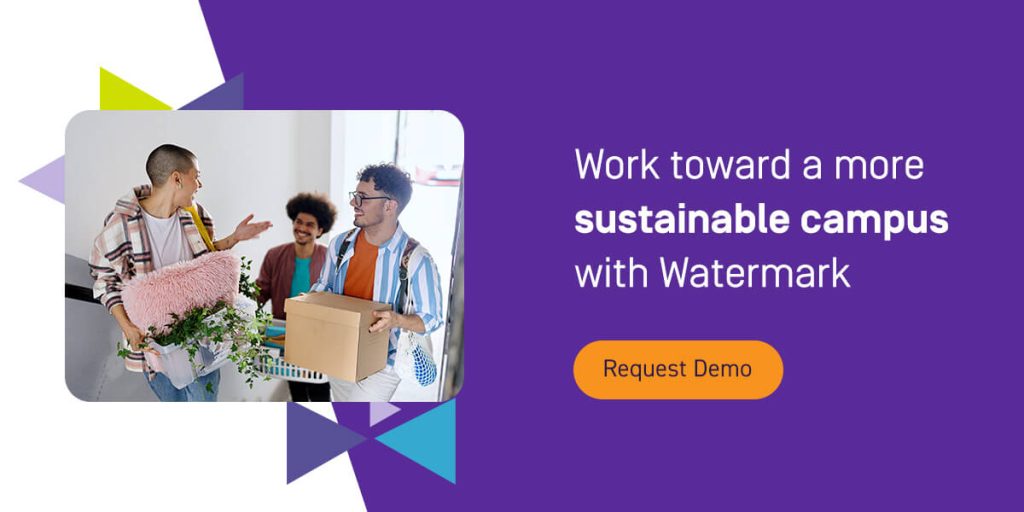




It’s high time that higher education took action against climate change. A recent survey from Inside Higher Ed (IHE) revealed that 85% of students perceive institutional sustainability as at least somewhat important. And 81% say climate change is a concern for them.
In fact, access to an inclusive, high-quality education is one of the UN’s 17 sustainable development goals (SDGs) — a set of social, environmental, and economic objectives for a more sustainable future.
So, what does it mean for a higher education institution to go green? Essentially, it means the institution is committed to achieving the following goals:
Sustainability is a driving force in the higher education sector, with many institutions adopting it as the core element of their mission. And with all the advantages of investing in sustainability efforts, it’s clear that waiting to create a more environmentally friendly campus is the wrong move.
External stakeholders may not understand why sustainability is important in higher education, which can make it difficult to get the buy-in you need to invest in green projects. Investing campus resources in environmental sustainability has many benefits for higher education, including but not limited to:

Finding creative ways to make your institution more environmentally sustainable will be essential for survival as the global situation continues to evolve.
Need help getting started? Use these 12 ideas as inspiration for your initiative.
Your campus structures are the most obvious place to start when it comes to sustainability.
Designing campus buildings that meet the criteria for Leadership in Energy and Environmental Design (LEED) certification can help you cut energy costs, reduce your carbon emissions, and boost your reputation as a leader in sustainable education. Your institution can pursue LEED certification for both new and existing campus buildings, which provides proof of your environmental commitment to all internal and external stakeholders.
Some examples of improvements you can make include:
Digital transformation (DX) has been ongoing in the education sector for some time now, but with the rise of artificial intelligence and other advanced technologies, it’s picking up speed. Now, moving toward digital sustainability by moving traditionally paper-based processes online is the ultimate goal.
Not only will digitizing critical systems and processes make your campus more sustainable, but they’ll also boost your institution’s competitiveness within the sector. Automated data analytics and management solutions help you extract invaluable insights from the data your institution collects so you can boost revenue and reduce costs, whether it’s optimizing financial aid budgets or streamlining course evaluations.
And with digital skills becoming increasingly attractive to employers, now is the time for higher education institutions to accelerate their DX efforts both in and out of the classroom. That’s why it’s so important to encourage faculty to better support your students in their career goals by incorporating more tech tools into academic programming.
From paper exams to disposable cups and plates, higher education institutions consume high quantities of paper.
Some ways to cut down on campus paper waste include:
Moving away from paper systems has administrative benefits, too. Paperless data management through integrated, cloud-based data analytics tools enables your institution to generate actionable insights on demand for agile decision-making and easy communication with all key stakeholders.
The vast majority of students say they recycle, which is why institutions need to put the proper infrastructure in place to encourage this behavior. To determine your goals for this task, first perform a waste audit — this evaluation will help you set the benchmark against which you’ll compare your progress moving forward.
Once you know what you’re aiming to beat, you can get started improving recycling rates by:
Composting and recycling go hand in hand in turning campus waste into new products. In composting’s case, though, the end product is a highly nutritious organic matter you can add to soil to help encourage plant growth. If your institution decides to create a community garden, you can connect your composting center to it to create a circular economy.
Many institutions have established composting centers for students and staff to get rid of biodegradable waste such as:
Generally speaking, it’s best to avoid composting animal products like meat and dairy because the smell attracts pests — which can negatively impact the campus experience.
According to the 2023 Plastic Waste Makers Index, we’re producing more single-use plastic waste than ever before. While higher education institutions are far from the worst polluters, it’s still true that colleges and universities produce a high amount of plastic waste. Cutting back on the amount of disposable plastic products your institution purchases can significantly improve your sustainability.
Your dining hall is one of the easiest places to start. For example, you could switch to reusable or compostable plant-based cutlery at grab-and-go campus dining locations to cut down on waste from single-use plastic utensils. Some campuses have also launched lunch box programs, where students receive a complimentary reusable lunch box made from biodegradable plastic as part of their meal plan to discourage the use of disposable food containers.

Although most residential students walk or bike around campus, your commuters, faculty, and staff still need to drive to and from class every day. And when the average passenger vehicle produces 4.6 metric tons of carbon dioxide each year, those daily trips add up fast.
Many institutions have established transportation programs to reduce these emissions, such as:
Campus gardens teach students valuable lessons about caring for the land and encourage them to put those lessons into practice. Students can experiment with different sustainable growing methods to produce fresh fruits and vegetables, and your campus will benefit from increased pollination and social involvement.
Some of the other benefits of campus gardens include:
Students who care about sustainability and environmental issues want to take action, which is why creating curricula that include environmental skills can increase student engagement and satisfaction. Opening or expanding environment-centric academic programs like environmental engineering or energy and sustainability policy can help you attract new students who want to pursue a degree or certificate in the field.
You can also incorporate sustainability and environmental ethics into existing academic programs that may seem unrelated, like sociology or communications. Curriculum mapping using modern software solutions will help you map environmental learning outcomes to courses in specific programs to clearly articulate how these courses prepare students to take on climate change once they graduate.
The opportunity to work out of environmental research laboratories at prestigious institutions attracts both students and faculty interested in making a difference in the world. To accommodate this need, many institutions have established sustainability and environmental studies departments dedicated to researching innovative solutions for the problems that plague our world.
Plus, the work your researchers produce can help you be accountable to your key institutional stakeholders, which is important for securing funding for future opportunities. Generating visually striking reports on research progress using real-time data analytics solutions is a great way to hold your institution accountable, as it gives stakeholders a clear vision of what you’re using their dollars for.
Although one million plastic water bottles are purchased every minute globally, higher education institutions have the power to cut back on this plastic waste. Your students may already have begun this step for you — approximately 80% of college students use refillable water bottles, which can last as long as 10 years with the proper care.
Meet your students where they are by installing filtered bottle refilling stations throughout your campus. Strategically placing them throughout academic buildings and residence halls will increase the likelihood that students will use them, thus justifying your investment.
For many institutions, digitizing administrative processes is a great place to begin the sustainability journey. Partnering with Watermark can help you get there.
Our advanced, fully integrated software suite enables your institution to shift away from traditional paper-based evaluations and assessments so you can move toward more sustainable processes. Plus, robust on-demand reporting capabilities let you generate real-time insights for agile decision-making.
Watermark can help your institution be part of higher education’s green future. Get started today by requesting your personalized demo.






























































































































































































































































































































































































